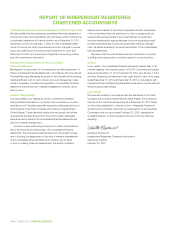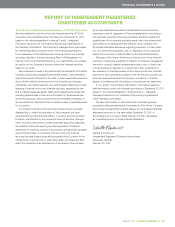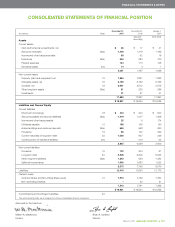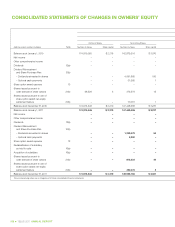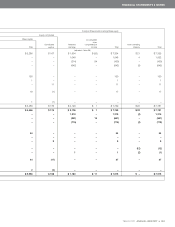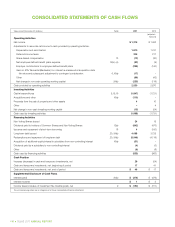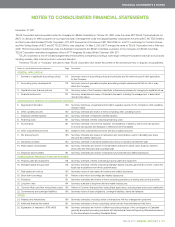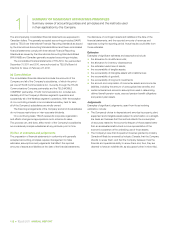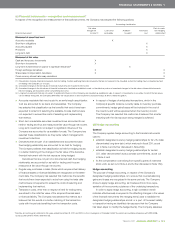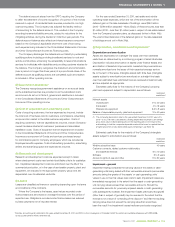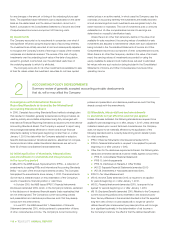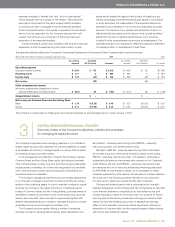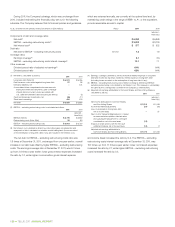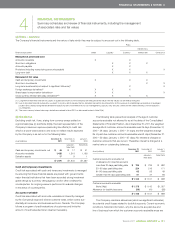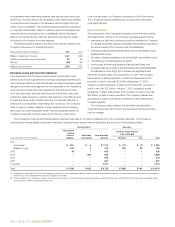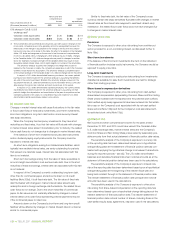Telus 2011 Annual Report Download - page 118
Download and view the complete annual report
Please find page 118 of the 2011 Telus annual report below. You can navigate through the pages in the report by either clicking on the pages listed below, or by using the keyword search tool below to find specific information within the annual report.114 . TELUS 2011 ANNUAL REPORT
the anticipated effectiveness of designated hedging relationships at
inception and actual effectiveness for each reporting period thereafter.
A designated hedging relationship is considered effective by the
Company if the following critical terms match between the hedging item
and the hedged item: the notional amount of the hedging item and
the principal of the hedged item; maturity dates; payment dates;
and interest rate index (if, and as, applicable). As set out in Note 4(i),
any ineffectiveness, such as would result from a difference between
the notional amount of the hedging item and the principal of the hedged
item, or from a previously effective designated hedging relationship
becoming ineffective, is reflected in the Consolidated Statements of
Income and Other Comprehensive Income as Financing costs if in respect
of long-term debt, as Goods and services purchased if in respect of
U.S. dollar denominated future purchase commitments or as Employee
benefits expense if in respect of share-based compensation.
Hedging assets and liabilities
In the application of hedge accounting, an amount (the hedge value) is
recorded on the Consolidated Statements of Financial Position in respect
of the fair value of the hedging items. The net difference, if any, between
the amounts recognized in the determination of net income and the
amount necessary to reflect the fair value of the designated cash flow
hedging items on the Consolidated Statements of Financial Position is
effectively recognized as a component of other comprehensive income,
as set out in Note 10.
In the application of hedge accounting to U.S. dollar denominated
long-term debt that matured in fiscal 2011, the amount recognized in
the determination of net income was the amount that counterbalanced
the difference between the Canadian dollar equivalent of the value of
the hedged items at the rate of exchange at the statement of financial
position date and the Canadian dollar equivalent of the value of the
hedged items at the rate of exchange in the hedging items.
In the application of hedge accounting to the compensation cost
arising from share-based compensation, the amount recognized in the
determination of net income is the amount that counterbalances the
difference between the quoted market price of the Company’s Non-Voting
Shares at the statement of financial position date and the price of the
Company’s Non-Voting Shares in the hedging items.
(e) Revenue recognition
General
The Company earns the majority of its revenue (wireless network, data
(including television, Internet, data and information technology managed
services), voice local and voice long distance) from access to, and usage
of, the Company’s telecommunications infrastructure. The majority of
the balance of the Company’s revenue (other and wireless equipment)
arises from providing services and products facilitating access to, and
usage of, the Company’s telecommunications infrastructure.
The Company offers complete and integrated solutions to meet its
customers’ needs. These solutions may involve the delivery of multiple
services and products occurring at different points in time and/or
over different periods of time. As appropriate, these multiple element
arrangements are separated into their component accounting units,
consideration is measured and allocated amongst the accounting units
based upon their relative fair values (derived using Company-specific
objective evidence) and then the Company’s relevant revenue recognition
policies are applied to the accounting units. A limitation cap restricts
the consideration allocated to services or products currently transferred
in multiple element arrangements to an amount that is not contingent
upon the delivery of additional items or meeting other specified perfor-
mance conditions. The Company’s view is that the limitation cap results
in a faithful depiction of the transfer of services and products as it reflects
the telecommunications industry’s generally accepted understanding
of the transfer of services and products as well as reflecting the related
cash flows.
Multiple contracts with a single customer are normally accounted
for as separate arrangements. In instances where multiple contracts are
entered into with a customer in a short period of time, they are reviewed
as a group to ensure that, as with multiple element arrangements,
relative fair values are appropriate.
Lease accounting is applied to an accounting unit if it conveys the
right to use a specific asset to a customer but does not convey the risks
and/or benefits of ownership.
The Company’s revenues are recorded net of any value-added,
sales and/or use taxes billed to the customer concurrent with a revenue-
producing transaction.
When the Company receives no identifiable, separable benefit for
consideration given to a customer (e.g. discounts and rebates), the con-
sideration is recorded as a reduction of revenue rather than as an expense.
Voice local, voice long distance, data and wireless network
The Company recognizes revenues on the accrual basis and includes
an estimate of revenues earned but unbilled. Wireline and wireless service
revenues are recognized based upon access to, and usage of, the
Company’s telecommunications infrastructure and upon contract fees.
Advance billings are recorded when billing occurs prior to rendering
the associated service; such advance billings are recognized as
revenue in the period in which the services are provided. Similarly,
and as appropriate, upfront customer activation and connection fees
are deferred and recognized over the average expected term of the
customer relationship.
The Company follows the liability method of accounting for its quality
of service rate rebate amounts that arise from the jurisdiction of the
Canadian Radio-television and Telecommunications Commission (CRTC).
The CRTC has established a portable subsidy mechanism to
subsidize local exchange carriers, such as the Company, that provide
residential basic telephone service to high cost serving areas. The CRTC
has determined the per network access line/per band portable subsidy
rate for all local exchange carriers. The Company recognizes the portable
subsidy on an accrual basis by applying the subsidy rate to the number
of residential network access lines it has in high cost serving areas, as
further discussed in Note 6. Differences, if any, between interim and final
subsidy rates set by the CRTC are accounted for as a change in estimate
in the period in which the CRTC finalizes the subsidy rate.
Other and wireless equipment
The Company recognizes product revenues, including wireless handsets
sold to re-sellers and customer premises equipment, when the products
are delivered and accepted by the end-user customers. Revenues from
operating leases of equipment are recognized on a systematic and
rational basis (normally a straight-line basis) over the term of the lease.
Non-high cost serving area deferral account
On May 30, 2002, and on July 31, 2002, the CRTC issued Decision
2002-34 and Decision 2002-43, respectively, pronouncements that
affected regulated services in the Company’s Wireline segment. In
an effort to foster competition for residential basic service in non-high
cost serving areas, the concept of a deferral account mechanism was
introduced by the CRTC, as an alternative to mandating price reductions.


